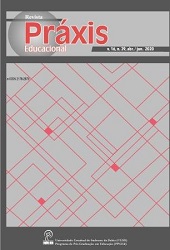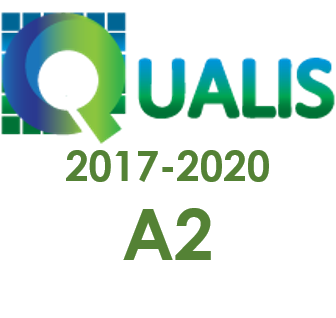QUANTITATIVE AND QUALITATIVE COMPONENTS AND INDICATORS OF PRODUCTIVITY IN EDUCATIONAL CENTERS
DOI:
https://doi.org/10.22481/praxisedu.v16i39.6375Keywords:
Quantitative and Qualitative Components, Qualitative and Quantitative Indicators, Educational Centers, ProductivityAbstract
The role of human resources in promoting productivity of service organizations is important due to the direct production and delivery of human services. Applying manpower motivated, empowered and productive, in addition to providing quality services, can utilize other resources within the organization efficiently and desirably and realize the various aspects of productivity and ultimately benefit the organization. Therefore, the purpose of this article is to quantitative and qualitative components and indicators in educational centers. This research was practical and descriptive. The population of this study included all educational centers in 2018. Sample size was estimated based on Krejcie and Morgan Table (123 people) that selected by stratified random sampling. Data collection tool was a questionnaire consisting of 4 components of educational requirements (4 items), quantitative indicators of education (4 items), qualitative indicators of education (8 items), external environment specificity (6 items), indoor environmental characteristics (7 items), characteristics of psychological environment (11 items) and strategic human resource management (5 items) that based on a five-point Likert scale from strongly disagreed to strongly agreed. The content validity of the questionnaire was confirmed by expert opinion. Cranach’s alpha coefficient of the variables was also higher than 0.7 that indicating internal consistency of the items and confirmation of reliability. Partial least squares method was used to test the research model by using PLS software. Based on the results, all identified components were significant in the default conceptual model and only the components of "quality of education" and "characteristics of the psychological environment" did not have a significance in forming the model of educational productivity in the present study.
Downloads
Metrics
References
Ali Pour, Hadith, Persia, Glory (2015), agents Effective On the productivity At Organization (Study Case: Kidney Employees office Culture And Guidance Islamic Ahvaz), Conference The International Management, Economy And industrial engineering, Tehran: Institute Managers Ideas Processor Capital Vira.
and Factors behind Slow Growth, International Journal of Finance and Economics, 23, 111-121.
Barro, RJ and Lee, JW (2013) 'A New Data Set of Educational Attainment in the World, 1950-2010'. Journal of Development Economics 104, 184-198.
Brothers, Vahid, Valliant, Maryam (2015), A Review Agents Effective On Upgrade However, the productivity the force human in organization Affairs Tax Country (Study Case office Total Affairs Tax East Tehran), Research a Tax, no twenty And Ninth ( machine gun77).
Gil-Alana, LA, and Mudida, R (2018), The Growth Rate Series in Kenya: Evidence of Nonlinearities
Hosseini Noddy, Seyedeh Maryam (1391), Relation Program planning Strategic Sources human With Productivity Office staff Central Bank Housing, End Letter Masters Senior, College Management, University Free Islamic Tehran Branch Central.
Isaac, Amir Hassan, (2015) Review Relation I among Management Criteria Time and Productivity the force human Item Study : Organization Social Security City Yazd, the first Conference National Science Management novel and planning Cultural social Iran, Qom :Center Studies and Islamic Research Soroush Wisdom Mortazavi.
Jones DC, Kalmi P, Kauhanen A (2006). Human resource management policies and productivity:new evidence from an econometric case study. Oxford Review of Economic Policy; 22 (4):526-38.
Leta J, Lannes D, De Meis L (2010). Human resources and scientific productivity in Brazil.
Li, C Murshed, M and Tanna, S. (2017). 'The impact of the Civil War on Foreign Direct Investment Flows to Developing Countries', Journal of International Trade and Economic Development, 26 (4), 488-507.
Li, C Tanna, S The impact of foreign direct investment on productivity: New evidence for developing countries, Economic Modeling (2019), doi:https://doi.org/10.1016/ j.econmod. 2018.11.028.
Moslehi, Abdollah, Salahi Kojour, Azim (1395), communication the power Managers And Management Time With Interest Sideways the force Human (at offices Sport And Youth State Mazandaran) , National Research Monthly, Vol First, No. 11.
Nabil Annabi (2017), “Investments in education: What are productivity gains?”, Received 28 November 2016; received in revised form 14 February 2017; accepted 10 March 2017 Available online 9 April 2017, Journal of Policy Modeling 39 (2017) 499-518.
Readings First, man A, 7336, Educational Management, Tehran, Publishers Abjad, p.8.
Rosales, P. (2015), The relationship between power and effectiveness of nurse managers, Social Science Information, 44 (1):41-63.
Scientometrics; 41 (3): 313-24.
Stowart, A (2015). The relationship between power supply and job enrichment managing director, European Journal of Scientific Research, ISSN 1450-216X Vol.25 No.2 .PP:143-154.
Downloads
Published
How to Cite
Issue
Section
License
You are free to:
Share - copy and redistribute the material in any medium or format; Adapt - remix, transform, and build from the material for any purpose, even commercially. This license is acceptable for Free Cultural Works. The licensor cannot revoke these freedoms as long as you follow the terms of the license.
Under the following terms:
Attribution - You must appropriately give credit, provide a link to the license, and indicate if any changes have been made. You may do so in any reasonable way, but not in a way that suggests that you or your use is endorsed by the licensor.
There are no additional restrictions - You cannot apply legal terms or technological measures that legally restrict others to make any use permitted by the license.










